Media Literacy
> Frkensara
> English
Deepfakes: Is This Video Even Real?
TheirTube. Identifying Trolls and Bots. We’d all like to believe that our online interactions are genuine.
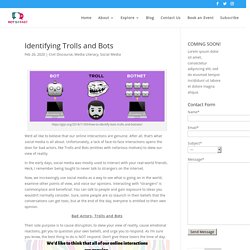
After all, that’s what social media is all about. Unfortunately, a lack of face-to-face interactions opens the door for bad actors, like Trolls and Bots (entities with nefarious motives) to skew our view of reality. In the early days, social media was mostly used to interact with your real-world friends. Heck, I remember being taught to never talk to strangers on the internet.
Now, we increasingly use social media as a way to see what is going on in the world, examine other points of view, and voice our opinions. Bad Actors- Trolls and Bots Their sole purpose is to cause disruption, to skew your view of reality, cause emotional reactions, get you to question your own beliefs, and urge you to respond.
Internet Troll and Disinformation Quiz. The Making of Fake News: A Case Study. Fact Finder: Your Foolproof Guide to Media Literacy. Evaluating Election Ads. E.S.C.A.P.E. Junk News. NewseumED. Are your students savvy searchers?

Can they spot the difference between a straight news article and an opinion piece? Do they recognize bias in their sources … or in themselves? You are in one of Fact Finder: Your Foolproof Guide to Media Literacy’s 11 flexible, multimedia lesson plans to tackle these challenges. Eight skill-building lesson plans introduce essential media literacy concepts through engaging explainer videos and colorful infographics that help students revisit, retain and apply the key concepts.
Disinformation Nation: Checking Your Emotions. Disinformation Nation: Is It Propaganda?
“Misinformation” vs. “Disinformation”: Get Informed On The Difference. Amid the coronavirus pandemic, we are all desperate for information.
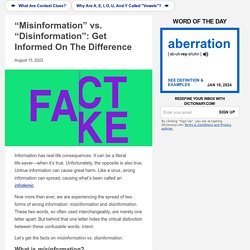
Where did the virus come from? Is there a cure? How can we keep staying safe? Will life get back to normal? In the case of COVID-19, information can be a literal life-saver—when it’s true. And now more than ever, we are seeing the spread of two forms of wrong information: misinformation and disinformation. Let’s get the facts on misinformation vs. disinformation.
Bias, fact and opinion. by rec208. Lesson Bias News Sources. Tips for Avoiding Fake News - Fake News - LibGuides at University of West Florida Libraries. #4: Distinguish Opinion from Fact Even news websites and programs have spaces or shows dedicated to people's opinions of news stories.
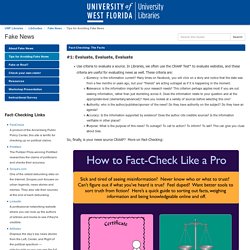
In newspapers, these sections may be called: Editorials Letters to the Editor Op-Eds. Bell Ringer: Evaluating Online News. NewseumED. Are your students savvy searchers? Can they spot the difference between a straight news article and an opinion piece? Do they recognize bias in their sources … or in themselves? You are in one of Fact Finder: Your Foolproof Guide to Media Literacy’s 11 flexible, multimedia lesson plans to tackle these challenges. Eight skill-building lesson plans introduce essential media literacy concepts through engaging explainer videos and colorful infographics that help students revisit, retain and apply the key concepts.
List of conspiracy theories. Wikipedia list article.
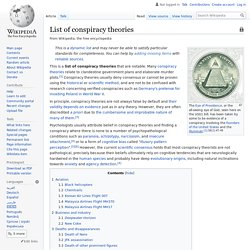
Conspiracy theories are dangerous—here’s how to crush them - Open Future. GONE ARE the days when conspiracy-mongers had to find shards of evidence and contort it to convince people.
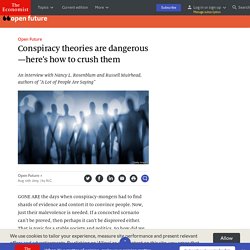
Now, just their malevolence is needed. If a concocted scenario can’t be proved, then perhaps it can’t be disproved either. That is toxic for a stable society and politics.
' Field Guide to Fake News Sites and Hoax Purveyors. The sharp increase in popularity of social media networks (primarily Facebook) has created a predatory secondary market among online publishers seeking to profitably exploit the large reach of those networks and their huge customer bases by spreading fake news and outlandish rumors.
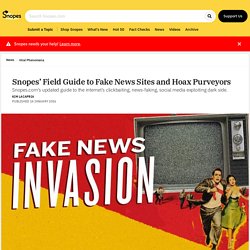
Competition for social media’s large supply of willing eyeballs is fierce, and a number of frequent offenders regularly fabricate salacious and attention-grabbing tales simply to drive traffic (and revenue) to their sites. Facebook has worked at limiting the reach of hoax-purveying sites in their customers’ news feeds, inhibiting (but not eradicating) the spread of fake news stories.
Pig Rescues Goat, and the Video Is Really Cute, but Totally Faked. It seemed too adorable to be fake, but it was too good to be true.
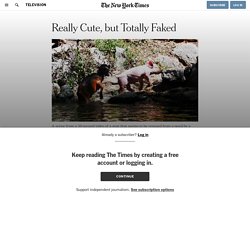
On Sept. 19 a 30-second video appeared on YouTube, depicting a baby goat that had become stuck in the pond of a petting zoo and that was heroically rescued with a helpful nudge from a pig that swam out to it. Within hours the video had been posted around the Web; it had been shared with the Twitter followers of Time magazine and Ellen DeGeneres; and it had been broadcast on NBC’s “Today” show and its “Nightly News” program, ABC’s “Good Morning America” and Fox News, where the “Fox & Friends” co-host Brian Kilmeade said of it, “You couldn’t do this at Warner Brothers as a cartoon and make it seem more realistic.”
But the video was thoroughly staged. It was created for a new Comedy Central series, “Nathan for You,” with the help of some 20 crew members, including animal trainers, scuba divers and humane officers, and required the fabrication of a plastic track to guide the pig to the goat (which was never in jeopardy). Mr.
From Gutenberg to Zuckerberg in 14 Lessons. The full News Literacy course, developed at Stony Brook University, organizes the material into 8 concepts that are spread amongst our 14 week course that take students from the first information revolution of Johannes Gutenberg's printing press to the Digital Age of Mark Zuckerberg's Facebook.
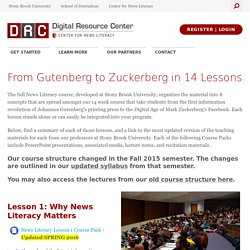
Each lesson stands alone or can easily be integrated into your program. Below, find a summary of each of those lessons, and a link to the most updated version of the teaching materials for each from our professors at Stony Brook University. Each of the following Course Packs include PowerPoint presentations, associated media, lecture notes, and recitation materials. Our course structure changed in the Fall 2015 semester. The changes are outlined in our updated syllabus from that semester. You may also access the lectures from our old course structure here.
Fake News vs. Real News: Determining the Reliability of Sources. Video and a related lesson plan from TEDEd. Update: Please also see our new, 2017 lesson, Evaluating Sources in a ‘Post-Truth’ World: Ideas for Teaching and Learning About Fake News _________ How do you know if something you read is true?
Why should you care? We pose these questions this week in honor of News Engagement Day on Oct. 6, and try to answer them with resources from The Times as well as from Edutopia, the Center for News Literacy, TEDEd and the NewseumEd. Although we doubt we need to convince teachers that this skill is important, we like the way Peter Adams from the News Literacy Project frames it in a post for Edutopia.
As he points out, every teacher is familiar with “digital natives” and the way they seem to have been born with the ability to use technology. Below, a roundup of tools, questions, activities and case studies we hope can help reduce this digital naïveté.
Most Students Don’t Know When News Is Fake, Stanford Study Finds. Preteens and teens may appear dazzlingly fluent, flitting among social-media sites, uploading selfies and texting friends.
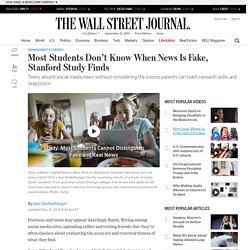
But they’re often clueless about evaluating the accuracy and trustworthiness of what they find. Some 82% of middle-schoolers couldn’t distinguish between an ad labeled “sponsored content” and a real news story on a website, according to a Stanford University study of 7,804 students from middle school through college. The study, set for release Tuesday, is the biggest so far on how teens evaluate information they find online. Many students judged the credibility of newsy tweets based on how much detail they contained or whether a large photo was attached, rather than on the source.
Social Media Companies Tackle Fake News and Abuse. Misleading Graphs: Real Life Examples - Statistics How To. Descriptive Statistics > Misleading Graphs Real Life Examples Misleading Graphs in Real Life: Overview Misleading graphs are sometimes deliberately misleading and sometimes it’s just a case of people not understanding the data behind the graph they create. The “classic” types of misleading graphs include cases where: The Vertical scale is too big or too small, or skips numbers, or doesn’t start at zero.The graph isn’t labeled properly.Data is left out.
But some real life misleading graphs go above and beyond the classic types. Misleading Graphs: The Missing Baseline. The Times leaves the rest behind…or does it? You might be thinking that the graph on the right shows The Times makes double the sales of The Daily Telegraph.
Misleading Statistics & Data – News Examples For Misuse of Statistics. Fukushima Nuclear Flowers. Recognizing Bias. Can Your Students Recognize Bias? 7 Tips for Teaching Media Literacy. In today’s environment, media literacy is more important than ever. But the sparse research on the topic shows us that kids really struggle with identifying legitimate sources. This Stanford study found that 82 percent of middle school students couldn’t distinguish between a news story and one labeled as sponsored content. Another 80 percent assumed that an unsourced photo was proof of a misleading claim. So how can teachers help? The following ideas can help students learn to recognize bias and evaluate their sources more carefully. 1.
Identify Bias - How to Evaluate Information Sources - ResearchGuides at New Jersey Institute of Technology. Why should we check the bias of information on a web page? Would you trust information unsupported by facts or logical reasoning? A biased author may not pay attention to all the facts or develop a logical argument to support his or her opinions. Bias is when a statement reflects a partiality, preference, or prejudice for or against a person, object, or idea.
Balanced news via media bias ratings for an unbiased news perspective. How To Tell Fake News From Real News In 'Post-Truth' Era. Behind the fake news crisis lies what's perhaps a larger problem: Many Americans doubt what governments or authorities tell them, and also dismiss real news from traditional sources. But we've got tips to sharpen our skepticism. Turnbull/Getty Images/Ikon Images hide caption toggle caption Turnbull/Getty Images/Ikon Images. A10 Moon Conspiracies. Why Rational People Buy Into Conspiracy Theories. Introduction to conspiracy theories by Zwenzini.










